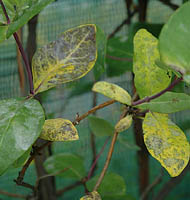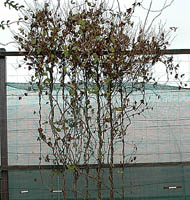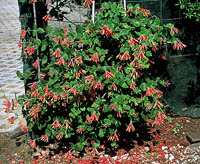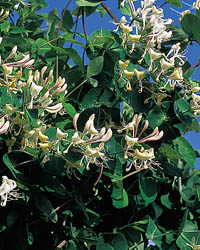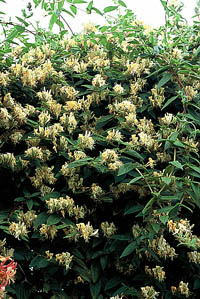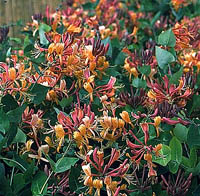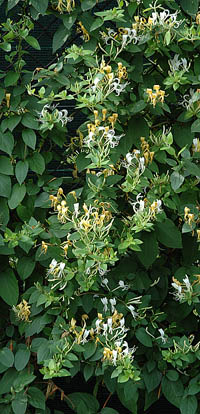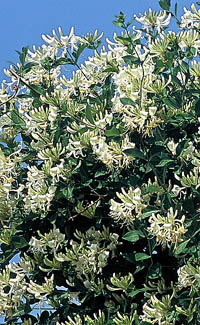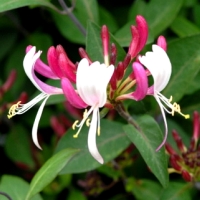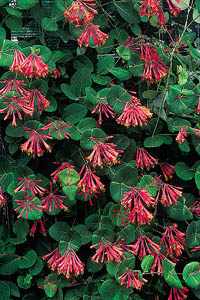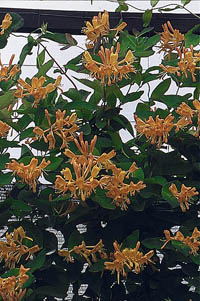Lonicera - honeysuckle
 A popular twining vine with ornamental tubular flowers that are sweet scented at some varieties, e.g. Perfoliate Honeysuckle, Woodbine, Japanese Honeysuckle, Goldflame Honeysuckle.
A popular twining vine with ornamental tubular flowers that are sweet scented at some varieties, e.g. Perfoliate Honeysuckle, Woodbine, Japanese Honeysuckle, Goldflame Honeysuckle.
The name Lonicera, commemorates Adam Lonitzer, 16th century German naturalist, the author of a well known herbal book. The genus Lonicera belongs to Caprifoliaceae family.
There are around 180 known Lonicera species growing in the wild in a northern hemisphere. The plants from the genus fall basically into two subgenera. The majority are arching shrubs classified in subgenus Lonicera. The other subgenus Caprifolium - Honeysuckle comprises vigorous vines whose stems twine spirally round a support. I would like to dedicate this article to the latter group.
There are around 20 species and several dozens cultivars of honeysuckles in cultivation around the world, of which around 20 taxons are cultivated in Poland. Honeysuckles have their leaves arranged in opposite pairs along the stems. In many species, the upper pair of leaves is joined together in a characteristic shape of a saucer. The foliage is most often green or green-blue, but can also be of a different colour e.g. Lonicera japonica 'Aureoreticulata' has green leaves with yellow veins, and Lonicera japonica 'Purpurea' has green leaves that turn red-purple in autumn and winter. The flowers are the indisputable attraction of honeysuckles - long tubular corollas can be white, yellow, crimson or violet and usually have two lips that curl outwards. What's more, they are fragrant in many species and cultivars. Honeysuckles start blooming in the 2nd - 4th year after planting. The flowers are produced in clusters of three, either arranged in pairs in leaf axils, or at the tops of the stems. Depending on the species, they appear between the end of May and October. Some honeysuckles also bear ornamental fruit - multi-seed berries with glossy skin that can vary in colour from bright orange through crimson to violet. They ripen from July to October and can serve as food for many birds, attracting them to your garden.
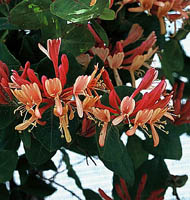 Lonicera heckrottii 'Goldflame' - photo Sz. Marczynski |
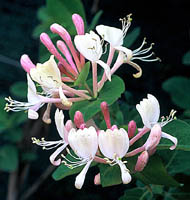 Lonicera caprifolium 'Inga' - photo Sz. Marczynski |
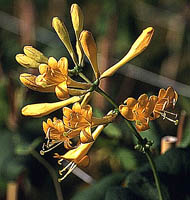 Lonicera x brownii 'Golden Trumpet' - photo Sz. Marczynski |
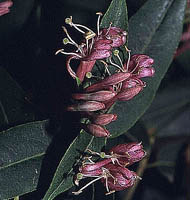 Lonicera henryi - photo Sz. Marczynski |
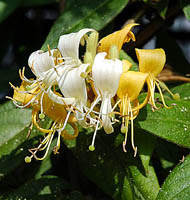 Lonicera acuminata - photo Sz. Marczynski |
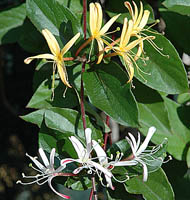 Lonicera japonica 'Purpurea' - photo Sz. Marczynski |
Requirements.
Honeysuckles tolerate the majority of soils with the exception of very poor and drying soil, although they perform best and bloom more profusely in neutral or slightly alkaline, permeable, fertile, clayish soil that is rich in hummus and moist but not waterlogged. They look most impressive in full sun, but at the same time it makes some species and cultivars more subject to aphids attack. Therefore the most universal position for a honeysuckle is a partially shaded spot, sheltered from hot southern sun and strong winds.
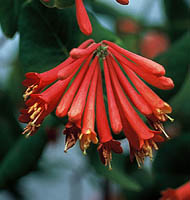 Lonicera x brownii 'Fuchsioides' - photo Sz. Marczynski |
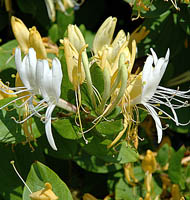 Lonicera japonica 'Halliana' - photo Sz. Marczynski |
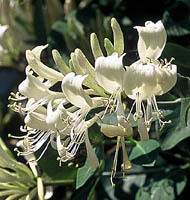 Lonicera periclymenum 'Graham Thomas' - photo Sz. Marczynski |
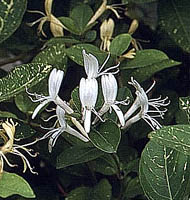 Lonicera japonica 'Aureoreticulata' - photo Sz. Marczynski |
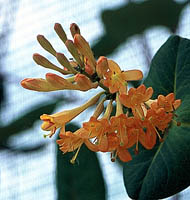 Lonicera x brownii 'Golden Trumpet' - photo Sz. Marczynski |
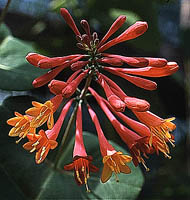 Lonicera 'Blanche Sandman' - photo Sz. Marczynski |
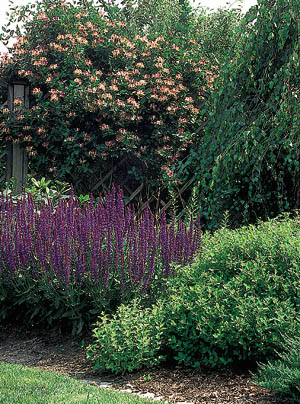 Lonicera periclymenum 'Serotina' - photo Sz. Marczynski |
Application.
Honeysuckles are some of the most valuable climbing plants and can be planted in any garden, but they look particularly imposing in a large, naturalist garden where they are free to grow in an unrestrained manner. They achieve a height of 3 - 6 m, with 0.5 to 2 m of new growth every year. They are perfect for covering walls, arches, gates, trellises, pergolas, arbours or old tree trunks, provided they are equipped with wires or a wire mesh that will allow the plants to climb. When grown over a fence, they create an attractive screen against wind, dust and inquisitive eyes of passers-by, replacing a hedge. Evergreen Lonicera acuminata is particularly suitable for this purpose. Some honeysuckles (e.g. Lonicera japonica 'Halliana' and 'Hall's Prolific') can be used as groundcover for covering large areas, also in public green spaces. Fragrant honeysuckles, e.g. Perfoliate Honeysuckle (Lonicera caprifolium), Woodbine (Lonicera periclymenum), Goldflame Honeysuckle (Lonicera x heckrottii), Japanese Honeysuckle (Lonicera japonica) and their cultivars, are best planted close to an entrance (a gate or a door), a window or a bank where you can admire their scent. Honeysuckles are a frequent element in traditional and rustic gardens. They can grow on their own or be combined with other climbers, such as a climbing rose or clematis (Clematis). It's best to use a vigorous clematis that requires hard pruning, e.g. a cultivar of the Viticella Group or any of the large-flowered late flowering clematis that are cut back just above the ground level in early spring. Otherwise, the pruning will be very difficult, since the clematis stems will intertwine with the honeysuckle stems.
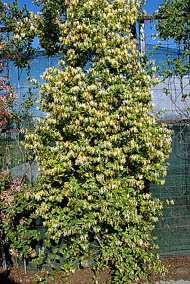 Lonicera japonica 'Halliana' - photo Sz. Marczynski |
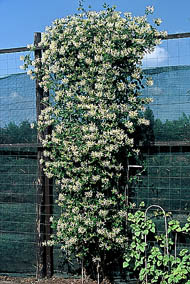 Lonicera periclymenum 'Graham Thomas' - photo Sz. Marczynski |
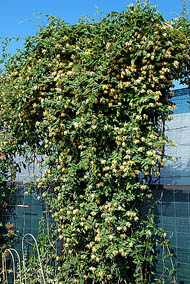 Lonicera acuminata - photo Sz. Marczynski |
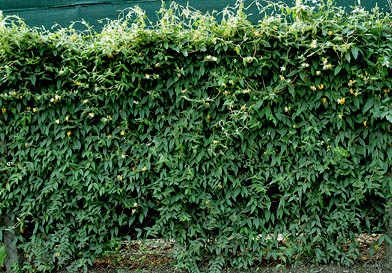 Lonicera acuminata on a fence - photo Sz. Marczynski |
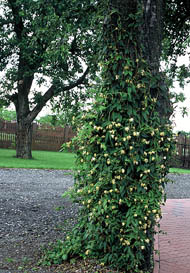 Lonicera acuminata on a tree - photo Sz. Marczynski |
Culture.
Most honeysuckles should be light pruned, only when need arises. They look at their best and produce best flowers when left to grow freely. However, if you want your plant to be really imposing, you should devote the first 1 - 3 years to establishing and forming it. After planting, cut all the stems at the 1/3 of the height to promote strong branching at the base. Then, choose 3 - 4 strongest shoots of the newly grown and remove all the rest. In the next years the honeysuckles that flower on old wood, like Perfoliate Honeysuckle (Lonicera caprifolium) or Lonicera x tellmanniana should be pruned very lightly, just to remove weak, dead or obstructing stems. The honeysuckles that bloom on new wood, such as Japanese honeysuckle (Lonicera japonia) and its cultivars or Goldflame Honeysuckle (Lonicera x heckrottii), can be pruned hard in early spring without the fear of losing flower crop. After several years, the base of the plant may start getting bare, the leaves and flowers only appearing at the upper part of the plant. To counteract this, carry out a rejuvenating pruning every 5 - 6 years. Spread the task over two years, each year cutting out the half of the oldest stems at the base of the plant.
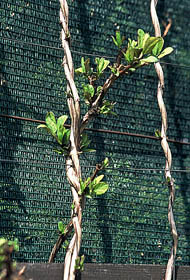 Lonicera japonica 'Halliana' - after spring pruning - photo Sz. Marczynski |
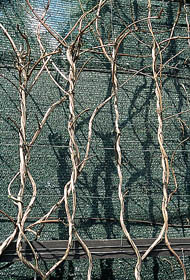 Lonicera periclymenum 'Serotina' - after spring pruning - photo Sz. Marczynski |
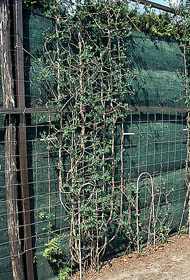 Lonicera x heckrottii 'American Beauty' - after spring pruning - photo Sz. Marczynski |
Honeysuckles benefit from abundant watering and fertilization. When you use a slow-release fertilizer, for instance Osmocote 5 - 6 M, one fertilization a year is sufficient, best done at the end of April. Use 20 - 30 g per plant (put 2 - 3 teaspoonfuls into 3 - 5 holes, each 5 cm deep).
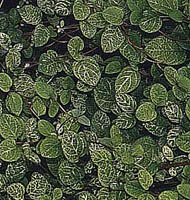 Lonicera japonica 'Aureoreticulata' - leaves - photo Sz. Marczynski |
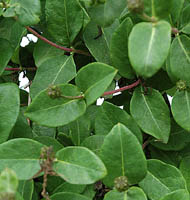 Lonicera periclymenum 'Graham Thomas' - leaves - photo Sz. Marczynski |
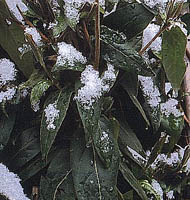 Lonicera acuminata - leaves - photo Sz. Marczynski |
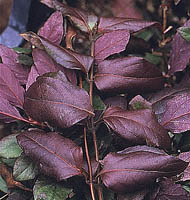 Lonicera japonica 'Purpurea' - leaves - photo Sz. Marczynski |
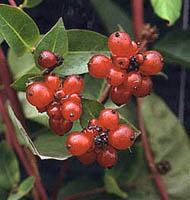 Lonicera periclymenum 'Serotina' - fruits - photo Sz. Marczynski |
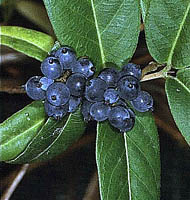 Lonicera henryi - fruits - photo Sz. Marczynski |
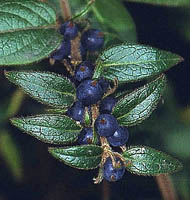 Lonicera acuminata - fruits - photo Sz. Marczynski |
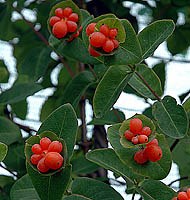 Lonicera caprifolium 'Inga' - fruits - photo Sz. Marczynski |
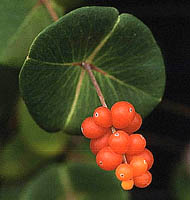 Lonicera x brownii 'Dropmore Scarlet' - fruits - photo Sz. Marczynski |
|
Diseases and Pests. Aphids are the most troublesome pest of honeysuckles. They appear at the top of the plant in May, just before the flowering. New shoots, leaves and flower buds are the main target of aphids,. Affected parts curl up, turn yellow, get deformed, stunted and covered with sticky honeydew. Perfoliate Honeysuckle (Lonicera caprifolium), Woodbine (Lonicera periclymenum), Tellmann Honeysuckle (Lonicera x tellmanniana) and Brown’s Honeysuckle (Lonicera x brownii) are particularly vulnerable to aphids attack, especially in a dry or sunny position. On the other hand, Henry’s Honeysuckle (Lonicera henryi), Japanese Honeysuckle (Lonicera japonica) and Lonicera acuminate are least susceptible to be attacked by aphids. To fight the pest off, spray the plant with a pesticide immediately after the first aphids have appeared.
Powdery mildew is the most dangerous honeysuckle disease. It causes the appearance of powdery white layer on the upper surface of leaves. With time, reddish or brownish stains appear and the leaves curl up, wither and drop. The susceptibility to the disease varies considerably among species and even cultivars. Perfoliate Honeysuckle (Lonicera caprifolium), is particularly vulnerable, but its cultivar 'Inga' is quite resistant and suffers minor damage.
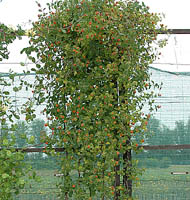 Lonicera caprifolium 'Inga' - cultivar party resistant to powder mildew - photo Sz. Marczynski |
Also, Lonicera acuminata, Henry’s Honeysuckle (Lonicera henryi) and most cultivars of Woodbine (Lonicera periclymenum), including 'Graham Thomas' and 'Serotina', and of Lonicera japonica (with the exception of 'Aureoreticulata') are quite tolerant of the disease. To fight the powdery mildew, spray the plant with one of the recommended fungicides. Repeat spraying 2 - 3 times every 10 days, each time with a different fungicide.
Species and cultivars.
|
- Lonicera acuminata. Native to north-eastern China. Linear, pointed, hairy, dark green, evergreen leaves can freeze during harsh winters. Small, tubular, two-lipped flowers are initially creamy and become yellow with age. Blooms profusely from June to October. The fruit are small violet-black berries. A vigorous climber up to 3 - 5m high, one of the best evergreen climbers in our climate. Well suited for creating screens and covering wire meshes, or as groundcover.
- Lonicera x brownii - Brown's Honeysuckle. Created about 1850 as a result of a cross between Lonicera hirsuta and Lonicera sempervirens. Oblong, blue-green leaves are joined at the tips. Slender, tubular, unscented, red flowers with orange throats are borne from July to September. Orange-red berries appear in July-August. It grows up to 3-4 m high.
- 'Dropmore Scarlet'. The most valuable of all Brown's Honeysuckle cultivars, raised in 1950 in Canada. Orange-red flowers are borne profusely from June to October. Decorative fruits similar to those of the species. Very frost hardy.
- 'Fuchsioides'. A slow-growing, compact cultivar up to 1.5 - 2 m high. Flowers profusely and over a long period from June to October bearing orange-crimson flowers. Particularly recommended for small gardens.
- 'Golden Trumpet. A long-flowering cultivar up to 3 m high. Copper-yellow flowers from June to October. Orange-red fruits as in the species.
- Lonicera caprifolium - Perfoliate Honeysuckle. Native to Caucasus and the Middle East, but very popular in Poland. Often confused with the Polish variety Woodbine (Lonicera periclymenum), from which it differs in being more susceptible to powdery mildew and having the upper leaves joined. Very fragrant creamy flowers in May-June, followed by orange fruits in July-September. Ovate to obovate, glabrous, grey-green leaves. The upper pair of leaves (just below the corolla) are joined to form a 'saucer'. It grows up to 6 m high.
- 'Inga'. Pink flower buds open to creamy-white flowers. Blooms in May-June, 7 - 14 days longer than the species. Young leaves and shoots are slightly pubescent. Quite tolerant of powdery mildew. A recommendable cultivar, more valuable than the species.
- Lonicera x heckrotti - Goldflame Honeysuckle. A spontaneous cross between Lonicera americana and Lonicera sempervirens. Introduced to cultivation at the end of the 19th century, it's considered as the most valuable of all honeysuckles. Lineal, oval or elliptic semi-evergreen or deciduous leaves are dark green on the surface and blue-green underneath. Carmine flower buds open to fragrant flowers, pink on the outside and orange-yellow inside. Exceptionally long and free flowering from June to September. The stems are either stiff or slightly twining in habit. It can also be grown as a shrub. It attains the height of 3-6 m.
- 'American Beauty'. Bright orange, unscented flowers appear from June to September, followed by crimson-orange ornamental berries in August-October.
- 'Goldflame'. Very similar to the species but the flowers are fragrant and have a slightly more intense colour. Blooms from June to September.
- Lonicera henryi - Henry's Honeysuckle. Native to China. Lanceolate glossy dark green evergreen leaves. Small tubular deep purple-violet flowers are not very numerous, they appear in June-July. Small violet-black berries with pale waxy bloom are produced in August-October. It may freeze in harsh winters. Grow in a sheltered, partially shaded or shaded site. It grows up to 3 m high.
- Lonicera japonica - Japanese Honeysuckle. Semi-evergreen climber up to 3 - 6m high, native to Japan, Korea and China. Wide elliptic to ovate green leaves. Tubular, 2-lipped, intensely fragrant flowers, that are initially creamy-white and become yellow at the end of the flowering period, borne through all summer. Blue-black berries. Its cultivars are more valuable than the species and are more recommended.
- 'Aureoreticulata' - Interesting, green leaves with yellow veins, the variegation is most prominent in full sun. Small, slightly fragrant flowers, borne from June to October, are initially white and turn yellow with age. It may be used either as a climbing plant or as groundcover. Susceptible to powdery mildew. It may freeze in harsh winters.
- 'Halliana' - A vigorous semi-evergreen climber covered from June to October with a mass of small, fragrant flowers that are creamy-white on opening and turn yellow with age. It attains a height of 5 m. It also be used as groundcover over large areas. Suitable for covering fences and creating various kinds of screens. Excellent for public green space.
- 'Hall's Prolific' - A cultivar selected in Holland from 'Halliana', its flowering period starts earlier, it lasts longer and is more profuse. It has similar applications and growth habit to 'Halliana' but it's less frost hardy.
- 'Purpurea' - Evergreen or semi-evergreen leaves, green with purple veins in summer and deep purple in autumn and winter. Small, tubular, fragrant flowers, violet outside. The inside of the corolla is initially white and turns yellow with age. Grows up to 4m high (1-2 m of new growth a year).
- Lonicera periclymenum - Woodbine. A popular vigorous climber up to 7 m high, native to Central and Western Europe as well as northern Africa. In Poland it’s a protected species, which grows in the wild in Pomerania and Lower Silesia. Ovate to oval leaves, green on the surface, blue-green underneath. They are paired at leaf axils but not joined (what distinguishes it from Lonicera caprifolium. Intensely fragrant, creamy flowers sometimes streaked red, borne from May to July. Decorative, deep red, glossy berries from July through autumn. It's more valuable and more disease resistant than Lonicera caprifolium. Its cultivars are particularly recommendable:
- 'Belgica Select' - An early-flowering, Dutch cultivar up to 3 m high (1 m of new growth a year). Purple-veined leaves. Young shoots and flower stalks are purple-violet. Pale, violet-black flowers are borne intermittently from May to October. The inside of the corolla is initially creamy and become yellow at the end of the flowering. Decorative red berries in September-October.
- ' Chojnów' PBR - A new Polish cultivar introduced in 2006, up to 2 - 3 m high (1 m of new growth a year). Intensely fragrant, deep purple flowers on the outside, creamy on the inside. They are borne in great profusion along the height of the plant from June to September. Red berries from August to October. Leaves are purple-green when young and turn green with age.
- 'Graham Thomas' - A very valuable cultivar, named after an English naturalist. It blooms very profusely and over a long period, from May to September. Relatively large, intensely fragrant, tubular flowers, creamy at the beginning and yellow at the end of the flowering, are followed by ornamental, red, glossy berries (June to October). It grows up to 4 m high (1 - 2 m of new growth a year).
- 'Serotina' - The most frequently cultivated honeysuckle. A vigorous Dutch cultivar up to 3-6m high. It's quite late-flowering (2 - 3 weeks later than 'Belgica Select'). Intensely fragrant flowers, violet-red outside, creamy inside, are borne from June to September. Attractive, coral, glossy berries from July to October.
- Lonicera sempervirens - Trumpet Honeysuckle. A North American species. Semi-evergreen or deciduous leaves. Tubular flowers, red outside, yellow inside. It may freeze in harsh climates, and in such case it's better to use its more hardy cultivars.
- 'Blanche Sandman'. A valuable American cultivar, hardier than the species. Crimson outside, yellow inside flowers are borne in profusion and over a long period, from June to October. Orange fruits in July-October.
- Lonicera x tellmanniana - Tellmann Honeysuckle. A Hungarian species raised in 1920 as a cross between Lonicera sempervirens and Lonicera tragophylla, growing up to 5 m high. Oval to elliptic-ovate leaves are dark green on the surface and blue-green-white underneath. The upper pair of leaves is joined forming a sort of a saucer. Very ornamental, large, tubular, 2-lipped copper-yellow flowers are unfortunately unscented. Borne in June-July, they are followed by orange fruits in July-September. Plant in half-shade for best performance and flowers.
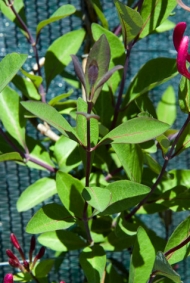 Lonicera periclymenum 'Chojnów' - leaves - photo Sz. Marczynski |
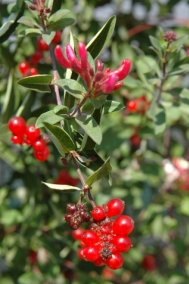 Lonicera periclymenum 'Chojnów' - fruits - photo Sz. Marczynski |

